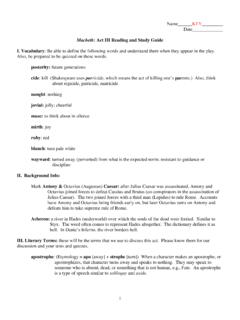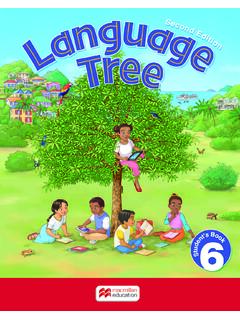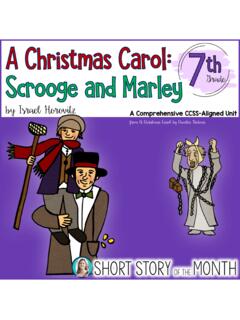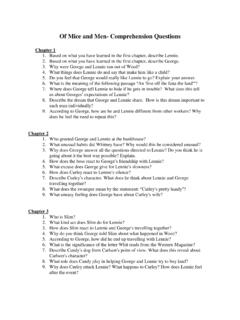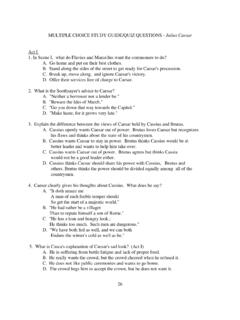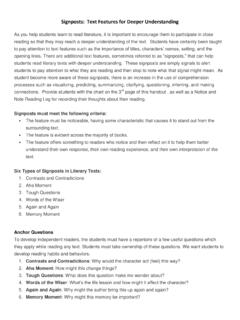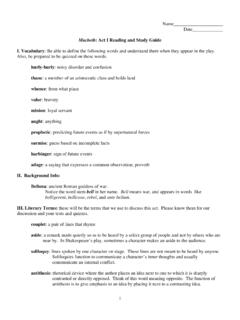Transcription of The Crucible: A Unit Plan
1 The Crucible: A Unit PlanSecond EditionBased on the play by Arthur MillerWritten by Mary B. Collins1 This version distributed by LLC. 1997 by Teacher's Pet Publications, RIGHTS RESERVED*Only the student materials in this unit plan such as worksheets,study questions, assignment sheets, and tests may be reproducedmultiple times for use in the purchaser s additional copyright questions, please LLC or Teacher s Pet :// OF CONTENTS - The CrucibleIntroduction 5 Unit Objectives 8 Reading Assignment Sheet 9 Unit Outline 10 Study Questions (Short Answer) 13 Quiz/Study Questions (Multiple Choice) 24 Pre-reading Vocabulary Worksheets 37 Lesson One (Introductory Lesson) 53 Nonfiction Assignment Sheet 55 Oral Reading Evaluation Form 57 Writing Assignment 1 67 Writing Assignment 2 70 Writing Assignment 3 82 Writing Evaluation Form 71 Vocabulary Review Activities 64 Extra Writing Assignments/Discussion ?
2 S 73 Unit Review Activities 78 Unit Tests 81 Unit Resource Materials 113 Vocabulary Resource Materials 127 A FEW NOTES ABOUT THE AUTHORARTHUR MILLERMr.
3 Miller was born in Harlem (New York) on October 17, 1915. Heattended public schools, but quit before graduation. He held odd jobssuch as farmhand, laborer, etc. Later, he got into The University ofMichigan where he wrote and attended classes. In 1938 he graduatedfrom The University of 1949 Mr. Miller won the Pulitzer Prize for Death of a 1953 The Crucible was produced on Broadway. Other notableworks by Arthur Miller include All My Sons, After The Fall, A ViewFrom The Bridge, The Price, Incident at Vichy, and The Misfits (amovie starring Marilyn Monroe, to whom he was once married.)--- Courtesy of Compton's Learning Company5 INTRODUCTION - The CrucibleThis unit has been designed to develop students' reading, writing, thinking, and language skillsthrough exercises and activities related to The Crucible by Arthur Miller. It includes nineteenlessons, supported by extra resource introductory lesson introduces students to the Puritans and witchcraft via a student-reportingand bulletin board-making activity.
4 Following the introductory activity, students are given atransition to explain how the activity relates to the book they are about to read. Following thetransition, students are given the materials they will be using during the unit. At the end of thelesson, students begin the pre-reading work for the first reading reading assignments are done orally for this play. The parts to be spoken during each classsession are listed on each lesson page. The teacher only needs to assign students to each have approximately 15 minutes of pre-reading work to do prior to each reading pre-reading work involves reviewing the study questions for the assignment and doing somevocabulary work for 8 to 10 vocabulary words they will encounter in their study guide questions are fact-based questions; students can find the answers to these questionsright in the text.
5 These questions come in two formats: short answer or multiple choice. The best useof these materials is probably to use the short answer version of the questions as study guides forstudents (since answers will be more complete), and to use the multiple choice version for occasionalquizzes. If your school has the appropriate equipment, it might be a good idea to make transparenciesof your answer keys for the overhead vocabulary work is intended to enrich students' vocabularies as well as to aid in the students'understanding of the book. Prior to each reading assignment, students will complete a two-partworksheet for approximately 8 to 10 vocabulary words in the upcoming reading assignment. Part Ifocuses on students' use of general knowledge and contextual clues by giving the sentence in whichthe word appears in the text. Students are then to write down what they think the words mean basedon the words' usage.
6 Part II nails down the definitions of the words by giving students dictionarydefinitions of the words and having students match the words to the correct definitions based on thewords' contextual usage. Students should then have a thorough understanding of the words whenthey meet them in the each reading assignment, students will go back and formulate answers for the study guidequestions. Discussion of these questions serves as a review of the most important events and ideaspresented in the reading students complete reading the work, there is a vocabulary review lesson which pulls togetherall of the fragmented vocabulary lists for the reading assignments and gives students a review of allof the words they have group activity which follows the vocabulary review has students working in small groups todiscuss several important aspects of the play.
7 Using the information they have acquired so farthrough individual work and class discussions, students get together to further examine the text andto brainstorm ideas relating to five specific aspects of the group activity is followed by a reports and discussion session in which the groups share theirideas about their topics with the entire class; thus, the entire class is exposed to information aboutall of the topics and the entire class can discuss each topic based on the nucleus of informationbrought forth by each of the lessons are devoted to creating and performing a scene in which Abigail is on trial for beingthe cause of death for those who died during the witch lesson is devoted to the extra discussion questions/writing assignments. These questions focuson interpretation, critical analysis and personal response, employing a variety of thinking skills andadding to the students' understanding of the are three writing assignments in this unit, each with the purpose of informing, persuading,or having students express personal opinions.
8 The first assignment is to inform: students write acomposition based upon their theme topics. The second assignment is to persuade: students are givena choice of letters to write from one character to another, persuading him or her of something. (Thetopic is given in the letter assignment.) The third assignment is to give students a chance to simplyexpress their own opinions: following the unit test, students write a composition explaining who, intheir opinion, is responsible for the Salem witch addition, there is a nonfiction reading assignment. Students are required to read a piece ofnonfiction related in some way to The Crucible (articles about witchcraft, Puritanism, theocracies,our judicial system, trial transcripts, etc.). After reading their nonfiction pieces, students will fill outa worksheet on which they answer questions regarding facts, interpretation, criticism, and personalopinions.
9 During one class period, students make oral presentations about the nonfiction piecesthey have read. This not only exposes all students to a wealth of information, it also gives studentsthe opportunity to practice public review lesson pulls together all of the aspects of the unit. The teacher is given four or fivechoices of activities or games to use which all serve the same basic function of reviewing all of theinformation presented in the unit test comes in two formats: all multiple choice-matching-true/false or with a mixture ofmatching, short answer, multiple choice, and composition. As a convenience, two different tests foreach format have been included. 7 There are additional support materials included with this unit. The extra activities packet includessuggestions for an in-class library, crossword and word search puzzles related to the play, and extravocabulary worksheets.
10 There is a list of bulletin board ideas which gives the teacher suggestionsfor bulletin boards to go along with this unit. In addition, there is a list of extra class activities theteacher could choose from to enhance the unit or as a substitution for an exercise the teacher mightfeel is inappropriate for his/her class. Answer keys are located directly after the reproduciblestudent materials throughout the unit. The student materials may be reproduced for use in theteacher's classroom without infringement of copyrights. No other portion of this unit may bereproduced without the written consent of Teacher's Pet Publications, OBJECTIVES - The Crucible1. Through reading Miller's The Crucible, students will gain a better understanding of the Salem witch trials and the Students will demonstrate their understanding of the text on four levels: factual, interpretive, critical and Students will consider the themes of crime and punishment, individual vs.

